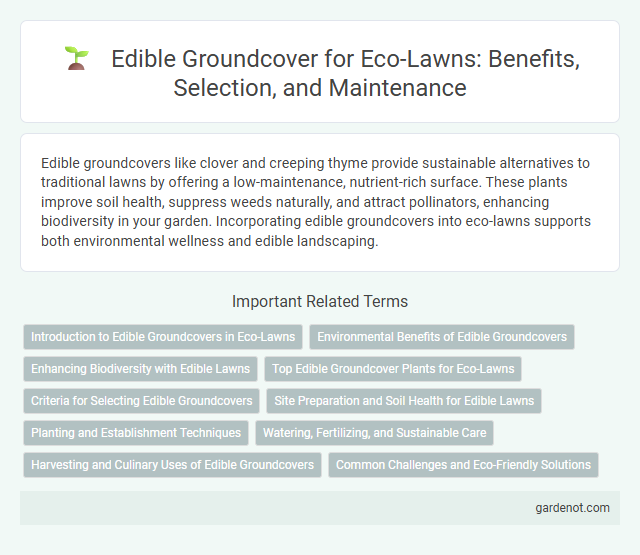Edible groundcovers like clover and creeping thyme provide sustainable alternatives to traditional lawns by offering a low-maintenance, nutrient-rich surface. These plants improve soil health, suppress weeds naturally, and attract pollinators, enhancing biodiversity in your garden. Incorporating edible groundcovers into eco-lawns supports both environmental wellness and edible landscaping.
Introduction to Edible Groundcovers in Eco-Lawns
Edible groundcovers in eco-lawns offer a sustainable alternative to traditional turf by combining functionality with food production, reducing water use and maintenance requirements. Species such as creeping thyme, clover, and wild strawberries provide nutritional value, improve soil health through nitrogen fixation, and enhance biodiversity in urban landscapes. Integrating edible groundcovers supports eco-friendly lawn management while fostering local food systems and pollinator habitats.
Environmental Benefits of Edible Groundcovers
Edible groundcovers, such as creeping thyme and clover, enhance soil health by fixing nitrogen and reducing erosion, which supports sustainable gardening practices. These plants increase biodiversity by providing habitat and food sources for pollinators like bees and butterflies, contributing to ecosystem stability. Furthermore, edible groundcovers reduce the need for chemical fertilizers and pesticides, lowering environmental pollution and promoting organic landscaping.
Enhancing Biodiversity with Edible Lawns
Edible lawns, featuring groundcovers like clover, creeping thyme, and wild strawberries, significantly enhance biodiversity by providing habitat and food sources for pollinators and beneficial insects. These plants improve soil health through nitrogen fixation and reduce the need for chemical fertilizers, promoting a more sustainable ecosystem. Integrating diverse edible species in eco-lawns fosters resilient green spaces that support local wildlife and contribute to ecological balance.
Top Edible Groundcover Plants for Eco-Lawns
Top edible groundcover plants for eco-lawns include creeping thyme, which thrives in sunny areas and offers fragrant leaves ideal for cooking. Clover varieties, such as white and red clover, boost soil nitrogen levels while providing a nutritious forage option for pollinators. Wild strawberries form a low-maintenance, fruit-producing carpet that enhances biodiversity and supports sustainable lawn alternatives.
Criteria for Selecting Edible Groundcovers
Selecting edible groundcovers requires evaluating factors such as climate adaptability, maintenance needs, and growth habit to ensure sustainable coverage and yield. Consider species like clover or creeping thyme that thrive in your local soil conditions while offering nutritional benefits and pest resistance. Prioritize groundcovers that prevent soil erosion, support pollinators, and integrate well with existing plants for a productive and eco-friendly lawn.
Site Preparation and Soil Health for Edible Lawns
Proper site preparation for edible groundcovers in eco-lawns involves thorough soil testing to determine nutrient levels, pH balance, and organic matter content, ensuring optimal growing conditions. Incorporating compost and natural amendments enhances soil health by improving texture, moisture retention, and microbial activity essential for nutrient uptake. Selecting well-drained sites with adequate sunlight exposure and minimizing soil compaction are critical to establish a productive, sustainable edible lawn.
Planting and Establishment Techniques
Edible groundcovers like creeping thyme and strawberries require well-prepared soil with good drainage and organic matter to establish successfully. Planting should occur during mild weather, spacing plants closely to encourage rapid coverage and minimize weed growth. Consistent watering during the initial weeks promotes deep root development essential for long-term resilience and productivity.
Watering, Fertilizing, and Sustainable Care
Edible groundcovers such as creeping thyme and clover thrive with moderate watering, ideally receiving about 1 inch of water per week to maintain healthy roots without waterlogging. Applying organic fertilizers like compost or seaweed extract twice a year supports nutrient-rich soil while minimizing chemical runoff, promoting sustainable growth. Sustainable care practices include mowing at a higher setting to encourage deep root development and using mulch to retain soil moisture and reduce weed growth.
Harvesting and Culinary Uses of Edible Groundcovers
Edible groundcovers such as wild strawberries, creeping thyme, and clover offer sustainable harvesting opportunities by providing continuous yields without the need for replanting. These plants enrich soil health while supplying fresh, nutrient-rich greens ideal for salads, garnishes, and herbal teas. Incorporating edible groundcovers into culinary practices supports eco-friendly gardening and introduces unique flavors and textures to everyday meals.
Common Challenges and Eco-Friendly Solutions
Edible groundcovers often face challenges such as soil nutrient depletion, pest infestations, and competition with invasive species that hinder growth and yield. Implementing organic mulching, companion planting, and integrated pest management promotes soil health and natural pest control while reducing chemical inputs. Selecting native or well-adapted edible species enhances resilience, supports biodiversity, and creates sustainable eco-lawns with minimal environmental impact.
Edible groundcover Infographic

 gardenot.com
gardenot.com